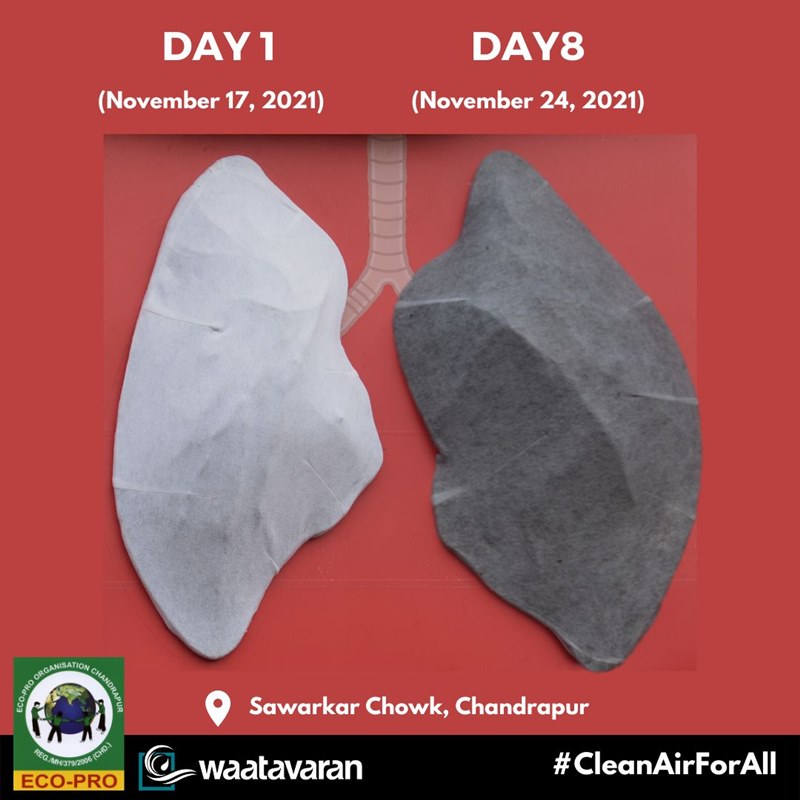A ‘chalk-white’ gigantic pair of faux lungs was installed at Chandrapur’s busy Savarkar Chowk on November 17. Within six days the lungs began to turn black and by the eighth day, there was not a spot of white to be seen on them.
“On Nov 17, when the lung billboard was installed, the daily average AQI was 207, the highest that week. Between November 17 to 24 the AQI crossed 200 on five days and came down slightly only due to the weather changes and rains. The weekly average AQI of the location has been 199, which also is very close to the ‘Poor’ category,” Farah Kazi, Director Campaigns at Waatavaran, said in a press statement on November 24.
The AQI level between 0-50 is considered ‘Good’ while 51-100 is ‘Satisfactory’; 101-200 is termed ‘Moderate’; 201-300 as ‘Poor’; while 301-400 is ‘Very Poor’.
This initiative is part of a campaign launched by Eco-Pro and Waatavaran Foundation, a non profit that works on climate change, environment and sustainability, to draw attention to the city’s deteriorating air quality. The campaign was supported by Chandrapur Clean Air Action Group.
Impact on health
The non-profit aims to raise awareness about the health consequences of the city’s increasing air pollution, with the use of the lung installation.
“This is for the first time that people can see and understand the health impact of breathing polluted air on their lungs. Everyone is talking about the ‘colour-changing lungs’, and we hope that the Chandrapur Municipal Corporation, which is supporting this campaign, takes note and initiates stringent action that will help improve air quality,” Bandu Dhotre, President Eco Pro and member of Chandrapur Clean Air Action Group, told Gaon Connection.
According to the health advisory, the statement said, in areas with ‘poor’ AQI, people with heart or lung disease, older adults and children should reduce exertion and prolonged outdoor activities. With ‘poor’ AQI, elderly are at a risk and even healthy people may start to experience slight discomfort, the advisory warned.
“Rising air pollution in Chandrapur is a matter of concern and can no longer be ignored given the several studies that indicated the health impact of air pollution. A first pan-India study conducted by Indian scientists found that areas with poor air quality and higher emissions of particulate matter (PM) 2.5 are more likely to have Covid-19 infections and related deaths. It is high time that all authorities take necessary steps to improve air quality,” Bhagwan Kesbhat, Founder, Waatavaran said.
The installation of the faux lungs drew the attention of people to the quality of the air they were breathing. The billboard also grabbed the attention of Chandrapur Member of Parliament (MP) Balu Dhanorkar and Member of Legislative Assembly (MLA) Kishor Jorgewar.
After visiting the lung billboard on November 24, they expressed concern about the rate at which the faux lungs had turned black. They have committed to raising this issue in Parliament and the State winter session of the assembly.
To respond to the city’s air pollution crisis, Municipal Commissioner for Chandrapur City Municipal Corporation Rajesh Mohite assured immediate steps would be taken to curb the pollution including measures such as managing and monitoring road dust, construction and demolition waste as well as domestic burning of coal.
Similar faux lungs were installed in Kharghar, Navi Mumbai, Maharashtra on January 15 this year. The white pair of lungs turned black in 10 days, causing alarm amongst the residents of the area.
Air pollution shortening lives
A recent report by Energy Policy Institute at the University of Chicago (EPIC) on Air Quality Life Index (AQLI) (a pollution index that translates particulate air pollution into its impact on life expectancy), reveals that nearly 40 per cent of India’s population is exposed to pollution levels not seen in any other country in the world.
The people of India are expected to lose 5.9 years of their lives on account of air pollution.
In Delhi, it is estimated that due to air pollution people’s lifespan is being reduced by 9.7 years.
Apart from the national capital, pollution has increased in the states of Maharashtra and Madhya Pradesh. For instance, the average person in these states is now losing an additional 2.5 to 2.9 years of life expectancy, when compared to early 2000.
Also Read: ‘Air pollution shortening lives by about 10 years in Delhi and UP’



















